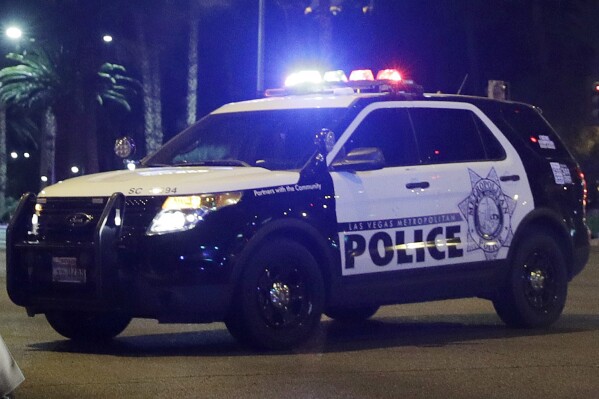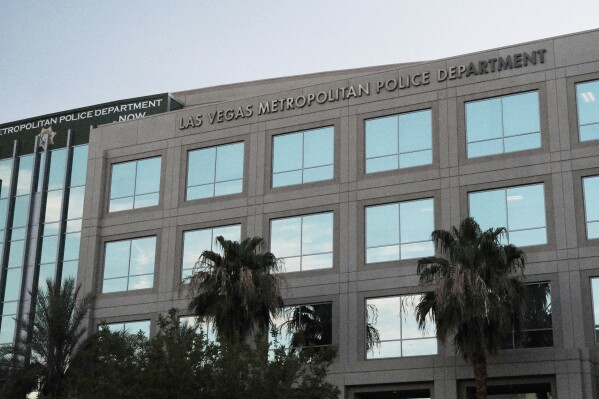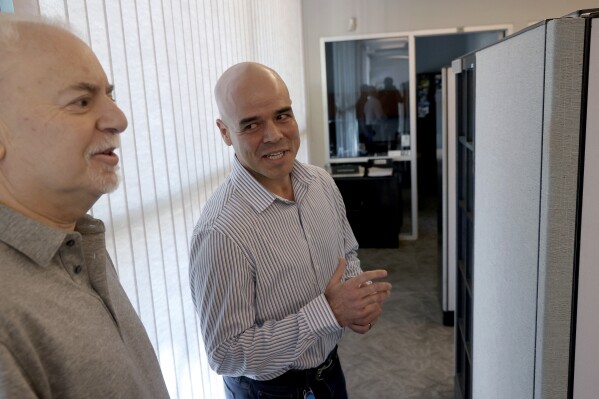How non-shooting deaths involving police slip through the cracks in Las Vegas
LAS VEGAS (AP) — Richard Ybanez always saw himself as his little brother’s protector.
Growing up as latchkey kids on Guam, he and Glenn spent their childhood mostly outdoors, tinkering with bicycles and riding skateboards. If anyone tried to pick on his brother, Richard had his back.
But Richard wasn’t there the morning a Las Vegas police officer pulled over Glenn Ybanez and his girlfriend after she allegedly failed to signal before switching lanes. Glenn, a former Army combat medic studying to be a nurse, had struggled after his return from Iraq. He had two outstanding drug warrants and, according to the police report, tried to run before being tackled by an officer and onlookers. Paramedics transported the unresponsive Glenn to the hospital, where he was found to have a small brain bleed and abrasions, the report said.
He died two days later — on July 4, 2012 — at 37. The medical examiner ruled his death an accident.
In the years since he buried his brother in the Guam Veterans Cemetery on the U.S. territory in the Western Pacific, Richard Ybanez said he continues to believe police played a bigger role in Glenn’s death than they reported.



“I want the police officers and the (Las Vegas) Metropolitan Police Department to be accountable for their officer’s actions,” the older brother said by telephone from Guam.
Glenn Ybanez is one of at least a dozen people who died in Nevada from 2012 through 2021 during or shortly after encounters with police that did not involve a gun. That’s according to an investigation by the Howard Center for Investigative Journalism at Arizona State University, which collaborated with The Associated Press. Because these kinds of deadly police encounters may not be publicly reported, no one knows how many truly occur.
Roxann McCoy, past president of the Las Vegas chapter of the NAACP, noted that neither George Floyd, whose 2020 death prompted a national reckoning on police violence, nor Tashii Brown, who died in a 2017 encounter with Las Vegas police, were shot. But both died after what’s known as “less-lethal force,” she said, adding, “This is a force that proved to be just as deadly.”
The Las Vegas Metropolitan Police Department denied a public records request that would have shed light on the number of non-firearm deaths from police encounters. Officials also declined to discuss such deaths, agreeing to speak only about their successful police reforms involving guns.
With attention largely focused on reducing police shooting deaths, deaths after less-lethal force often escape the kind of public scrutiny that can lead to reforms. They are also less clear-cut than shootings, in part because they often involve a mental health or drug-induced crisis. Attorneys who represent the deceased and their families say that allows other cause-of-death theories to obscure police involvement in someone’s death.
“When you have a shooting case and somebody dies as a result, it’s pretty clear that the shot, you know, took them out,” said Andre Lagomarsino, a Nevada attorney who has litigated several high-profile police shootings and other death cases.
Most deadly encounters with police in Nevada’s largest city are still caused by shootings. But West Juhl, communications director for the American Civil Liberties Union of Nevada, noted that Las Vegas officers are “increasingly trained to rely less on their guns.”
“So what we see now is they’ll reach for these other, quote unquote, ‘less than lethal’ tools,” he said.
How often these methods prove lethal is “a mystery,” said Michael White, a criminology and criminal justice professor at Arizona State University.
Because data on such non-shooting deaths is not readily available, it’s difficult to do any meaningful analyses on local or national trends, he said.
“The federal government should be tracking this,” White said. “It’s disgraceful that they don’t.”
‘Less lethal’ in Las Vegas
The FBI attempted to create a comprehensive database on police use of force in 2019 and has since shared some limited data from agencies that voluntarily submitted information about use of force incidents that resulted in a death, serious bodily injury or deployment of a firearm.
But the Las Vegas Metropolitan Police Department — one of the country’s largest — said it provides information to the FBI only about deadly police encounters with a firearm. In other words, none of the non-shooting deaths the department’s officers were involved in would be reflected in the FBI data.
The department’s website has information on the number of shootings its officers are involved in each year, regardless of whether they caused death. But the department does not publicly report the number of non-shooting deaths from other types of police force. In fact, its website included only four of the eight deaths involving restraint that the investigation identified in Las Vegas.
To identify non-shooting deaths resulting from police encounters, reporters read thousands of pages of court documents and other reports obtained through public records requests to local and county law enforcement agencies, district attorneys’ offices and Nevada’s two largest medical examiners’ offices. Other leads came from local news reports and crowdsourced lists of deaths allegedly caused by police.
Eleven of the 12 deaths identified involved men, from 22 to 65. At least eight were people of color and, of those, five were Black. All but four deaths involved Las Vegas Metropolitan police officers.
Less-lethal force varied across the fatalities and included chokeholds and leg restraints. Some were held in a prone, or facedown, position, and one had his hands cuffed to a chain around his waist.
Records revealed that stun guns were used in three fatal encounters — including the death of Brown, a 40-year-old, unarmed Black man. Brown died in 2017 after a Las Vegas police officer shocked him multiple times, punched him in the head and put him in a chokehold for over a minute.
Several other fatalities also involved multiple uses of force.
Las Vegas police officers shot high-velocity bean bags, released a police dog and used a Taser on Michael Guillory in December 2021 after he was allegedly pulling on car door handles in his apartment complex while carrying a sword, according to a police report.
Guillory, a 37-year-old Black man who had served in the U.S. Army and suffered from post-traumatic stress disorder and schizophrenia, was taken to the hospital and died the next day. His autopsy report said the cause of death was a blood clot due to recent cocaine use.
Judith Guillory recalled watching as police confronted her son outside their apartment complex. “All I heard was ‘pow, pow, pow,’ and I ran as fast as I could. I’m trying to get to him. But the officer stopped me and I’m like, ‘Did you just shoot my son?’” she remembered asking.
The officer told her, no, and explained that he had been shot with a less-lethal weapon — bean bag rounds. “‘He’s going to be OK,’” she remembered him saying.
The medical examiner’s office later informed Guillory’s mother that her son — who once dreamed of becoming a social worker — had died from a blood clot.
Eleven of the 12 deaths found by reporters involved people who were on stimulant drugs, such as methamphetamine or cocaine, and several also had criminal backgrounds.
In four cases, including Ybanez’s, medical examiners ruled the fatalities as accidents. Three of the autopsies barely mention the police. The medical examiner in Ybanez’s case did address police actions but said the force was not a “substantive cause of death.”
Each of the four deaths ruled accidents were attributed, in part, to stimulant drugs. Experts say determining cause of death when methamphetamine or other stimulants are involved is challenging because lethal levels vary based on several factors, including a person’s weight, tolerance and history of drug use.
Clark County Coroner Melanie Rouse said the decision on whether to rule a death an accident versus a homicide is based on the individual case details and the findings of an independent investigation that relies in part on information from police. Multiple factors, including drug tolerances and interactions, are considered in determining whether a death was due to drugs, Rouse said.
___
Reporters Arlyssa Becenti, Rachel Konieczny, Brooke Manning and Juliette Rihl contributed to this story. It was produced by the Howard Center for Investigative Journalism at Arizona State University’s Walter Cronkite School of Journalism and Mass Communication, an initiative of the Scripps Howard Fund in honor of the late news industry executive and pioneer Roy W. Howard. Contact us at [email protected] or on X (formerly Twitter) @HowardCenterASU.
Disclaimer: The copyright of this article belongs to the original author. Reposting this article is solely for the purpose of information dissemination and does not constitute any investment advice. If there is any infringement, please contact us immediately. We will make corrections or deletions as necessary. Thank you.






